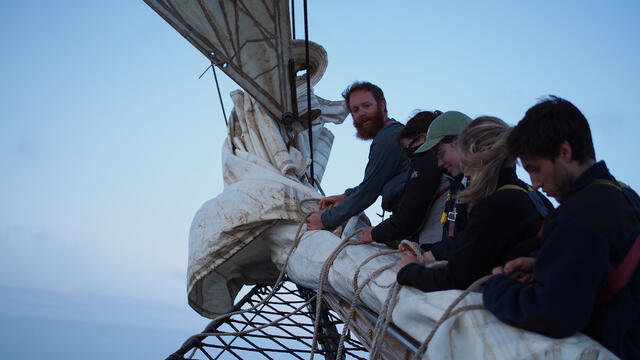Sailing the high seas for adventure and research

Before heading to Woods Hole, Mass., and boarding the tall ship he would help sail to Ireland, Ian Kasaitis ’18 had never been farther from his Maryland home than New Jersey.
But the lore of adventure coupled with encouragement from Biology professor Katie Staab fueled his application to SEA (Sea Education Association) Semester and what would be a life-changing experience.
“I had never been on an airplane let alone a ship in the Atlantic,” says the junior Biology major from Crofton, Md. “I wanted an adventure and to get off land and to do research.”
The five-week summer program was the perfect fit. Kasaitis was among a group of 15 college students, four scientists, four sailing interns and a crew of six who sailed a 134-foot, two-masted sailing research vessel across the Atlantic while conducting oceanic research. After a week on land at the oceanographic research mecca at Woods Hole, the group boarded the Corwith Cramer — their home away from home for the next four weeks.
“The first week we were all seasick , the second week we adjusted, the third week we loved it and the fourth we were all saying, ‘oh no, we don’t want to see land,’” says Kasaitis, who is following a pre-med program of study and planning to become a pediatrician.
Kasaitis studied and collected data on myctophids, a deep-sea fish that makes up 65 percent of the mesopelagic (660 to 3,300 feet below the ocean surface) biomass. He learned celestial navigations, how to deploy nets, how to plot a course and how to sail the brigantine.
On two watches during the final week of the voyage, he was given control of the ship and the lab as a junior watch officer. It was up to him to tell his shipmates what to do — it was up to him to sail this ship that stretched nearly one-half of a football field.
“In the beginning we were all strangers, but we quickly became friends and we came together in the philosophy of ship-shipmate-self,” he says. “Everyone offered to do something for someone else. Everyone compensated for others’ weaknesses.”
In fact, above all that he learned about research, about the ocean and about sailing, Kasiatis says the most important lessons centered on team dynamics, team building and pushing his own limits.
“I learned how to be a team member, what type of leader I am and how a group should function as a team,” he says. “Of course, with conducting research, being a crew member and learning how to sail, I also learned that I have the capacity to push myself past what I thought were my limits.”
Sailing through the remnants of tropical storm Colin — 16-foot swells and 40 mph winds — Kasaitis remembers looking out at the sea and clouds as the ship dipped up…then down. Waves crashed over the deck, but he had full confidence in the ship and the crew.
As the voyage neared its end, land became a foreign concept. The students couldn’t walk a straight line and wished they were still on the ship. He’ll have reminders of the trip and his research when SEA Semester sends his fish to him so he can study the effects of plastic on them for his senior capstone project.
The memories will be with him forever.
“It changed my mind about how I perceived the scale of the Earth, and I still think about what the night skies look like without light pollution and how spectacular the sunsets at sea are,” he says. “They promised the adventure of a lifetime.
“And yeah, it certainly was.”
Ian Kasaitis '18 sailed across the Atlantic while conducting oceanic research during a summer SEA Semester program.